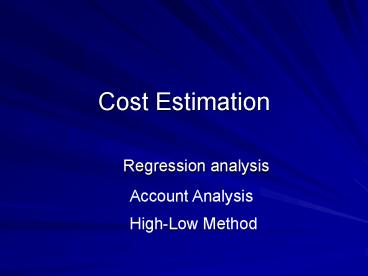Cost Estimation PowerPoint PPT Presentation
1 / 30
Title: Cost Estimation
1
Cost Estimation
- Regression analysis
Account Analysis
High-Low Method
2
What you need to know
- How to use a data set to run a regression
- How to interpret the results significance of
model, coefficients, what that means and how to
interpret the coefficients - How to use data to identify fixed and variable
costs - How to forecast costs, sales, etc.
- When to use the intercept and when to leave it
alone.
3
Cost estimation - Cost behavior
- We want to understand is how spending will
vary in a variety of decision settings. - Can we separate the fixed and variable costs?
- Cause-effect relations and costs drivers.
4
- When is it important to understand how overhead
costs behave? - When making price, production, process and
product design decisions. - When making bid or make or buy decisions.
- When we need to answer what if questions.
5
Mixed overhead cost behavior
Total Power Cost
The fixed part thevertical intercept
Total Power Costs
The variablepart the slope
Production volume orother cost driver
6
Cost behavior linear function by assumption.
- TC FC VC(level of cost driver)
- where
- TC total cost
- FC fixed cost
- VC variable cost per unit of the cost driver,
- and sometimes the cost driver is represented by
X.
7
Total Cost Curve
A
B
C
D
8
What methods are available?
- Engineering estimates
- Account analysis (e.g., Hilton)
- Scattergraph and high-low estimates
- Statistical methods (typically linear regression)
9
Example
- Suppose management believes that the monthly
overhead cost (5000) in the factory is mixed.
It is believed to be 50 fixed and 50 variable.
The variable portion is believed to depend on
machine hours, which average 10,000 per month.
How would you show this as a linear equation? - TC 2500 .25(machine hours).
10
Scattergraph
Look at the data set in your handout.
- Suppose you have data on overhead costs and
machine hours for the past 15 months and you
believe there is a linear relation between the
two. - Can you look at the numbers and tell me if there
is a relation? - Can you easily determine whether the posited
relationship exists? - Plot the data and look for a relationship.
11
Plot of overhead costs vs.machine hours
12
High-Low cost estimation
- Find the variable cost per unit of the cost
driver (VC)
13
High-Low method Example continued
Look at the data set in your handout. Pick out
the month withthe highest level of activity
pick out the lowest. Whats O/H?
14
High-Low cost estimation
Estimate the total overhead cost during amonth
when 115 machine hours will be used
15
Cost estimation using regression
- Y the dependent variable (often, total O/H
cost) - X the explanatory variables
- Y ?????X ???
- where X machine hours and ? random error.
- TC FC VCX ?.
16
Regression fits a line through these data points
17
Regression parameter estimates
- OLS estimators
- Desirable properties of estimators
- Unbiased (consistent)
- Efficient
- Assumptions (independent errors, constant
variance, the expected value of the error is
zero, normally distributed, non-stochastic
independent variable/s)
18
Simple linear regression
- One explanatory variable
- Cost estimation equation
- Coefficient of correlation (R)
- Coefficient of determination (R2)
- Goodness of fit
- Measure of importance
- F-statistic (hypothesis testing)
- p-value
19
The F statistic
- Goodness of fit hypothesis testing
- Compute a statistic from regression results
- Compute the associated p-value, or
- Look up a critical F-value and compare after
matching on - 1 numerator degree of freedom
- (n-2) denominator degrees of freedom
- alpha .05
20
The F test
- The null hypothesis is The slope coefficient is
zero or that F is really 1. This means there is
no relation between the y and the x measures, so
the mean is just as good as our regression
predicted value. - The F-statistic measures the loss of fit that
results when we impose the restriction that the
slope coefficient is zero. - If F is large, the null hypothesis is rejected.
21
The p-value
- This is the probability that the statistic we
computed could have come from the population
implied by our null hypothesis. - Suppose we hypothesize that the slope coefficient
is zero. - If the p-value associated with the F-statistic is
small, chances are the slope coefficient is not
zero.
22
Regression Plot
3750
3500
3250
3000
Y 2504 - 0 X R2 .0
2750
New O/H Cost
2500
2250
Y 2782.765 - 3.047 X R2 .026
2000
1750
1500
1250
40
50
60
70
80
90
100
110
120
130
140
150
Machine Hours
23
Regression result interpretation
24
Simple linear regression
O/H 2468 0 Machine Hours
25
Results using DM
26
Multiple regression
New assumption No degradingmulticolinearity
27
Forecasting overhead
- Predict monthly overhead when machine hours are
expected to be 62 and direct materials costs are
expected to be 1,900. - Recall
- ? 1,333.96
- Coefficient for mhrs 4.359
- Coefficient for DM .258
Overhead 1,333.96 4.359 mhrs .258 DM
28
Predicted overhead
29
Putting together a bid
- Calculate a minimum bid for a contract that would
use 22 machine hours and 900 of direct
materials. This would be a one-time-only job. - What if there is no idle capacity?
- Would your bid change if there were potential for
repeated business?
30
The end!

